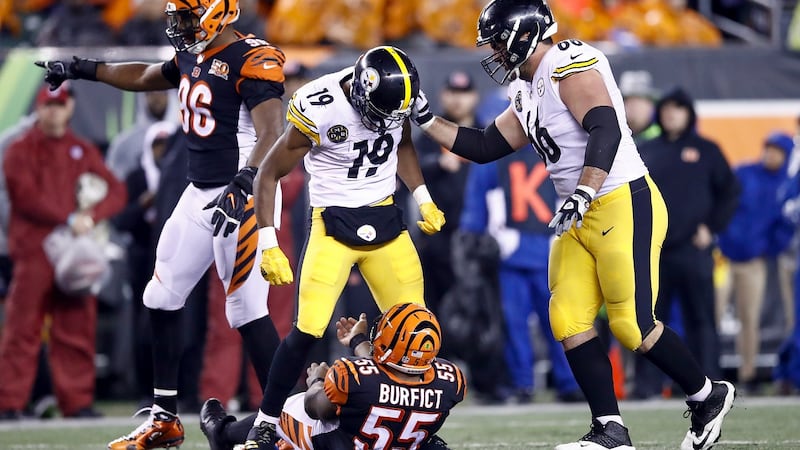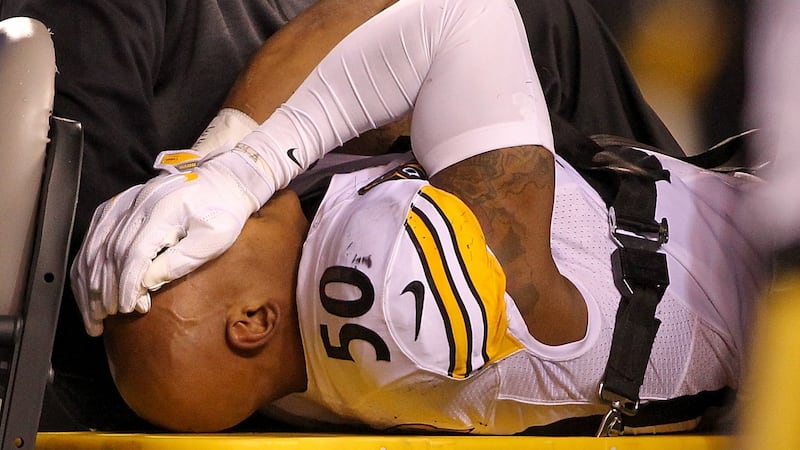The body count included a pair of young men carted off on stretchers and still more knocked out with serious injuries. Some were a result of routine plays that embody football’s existential risks, others were the offspring of more sinister intentions. Who can say, as the medics rush the field before a hushed stadium or from the antiseptic fluorescent buzz of a hospital room, which brand of violence is more concerning? Does it even matter?
One thing’s for certain: the grim tableau of carnage that was Monday night’s divisional grudge match between the Pittsburgh Steelers and Cincinnati Bengals, beamed in 4K ultra-high-definition to a national audience, comes at the worst possible time for a league beset with problems from all sides.
The first sobering moment came early on when Ryan Shazier, the Steelers' Pro Bowl linebacker, immediately reached for the middle of his back after a delivering a head-first hit across the middle. The game was halted for several minutes as the 25-year-old was strapped to a backboard, carted off the field and taken to the hospital for tests amid fears of a spinal injury. (Thankfully, he will not require surgery "at this time".)
What came next was hardly unavoidable: a parade of illegal hits and deliberate head shots between regional rivals bound by a well-documented antipathy. Steelers rookie JuJu Smith-Schuster detonated a vicious blindside block on Bengals linebacker Vontaze Burfict then preened over his motionless victim, prompting unfettered disgust from ESPN commentators Sean McDonough ("shame on him") and Jon Gruden (who called it "sickening"). Not long after, Cincinnati safety George Iloka punctuated a game-tying touchdown catch by Pittsburgh star Antonio Brown with a late, high hit. (Iloka and Smith-Schuster have been suspended one game for their actions).

Pittsburgh quarterback Ben Roethlisberger, when asked to assess the brutality of the night in the immediate aftermath, offered a chilling assessment: "AFC North football."
The Steelers’ comeback from 17-0 down in a prime-time game bursting with playoff implications should have been the topline, but the reaction from NFL insiders spoke volumes.
"This game is hard to watch for a number of reasons," tweeted Hall of Fame quarterback Troy Aikman. "Terrible for the NFL and the game of football overall."
"It's beyond football," Minnesota Vikings wideout Cris Carter said on Tuesday morning. "This isn't what competition is about."
Added one longtime Pittsburgh Tribune-Review correspondent: "Tonight in Cincinnati a lot of truly terrible things happened. One NFL team scored more than the other, but nobody 'won.'"
For a league that's made a strategic effort to persuade the public that it's a worthy American pastime and not merely a vehicle for gratuitous violence, this was hardly a banner night. Television ratings continue to languish along with the quality of play. Look no further than the actual roll of starting quarterbacks for Week 13's games, a who's who that included: Jacoby Brissett, Ryan Fitzpatrick, Blaine Gabbert, Brett Hundley, DeShone Kizer, Josh McCown, Matt Moore, Tom Savage, Trevor Siemian, Geno Smith, Mitch Trubisky. Say nothing of the ongoing showdown with the president of the United States that's represented a nightmare scenario for Roger Goodell's pathologically apolitical operation as it's ballooned into the biggest story in American sports.
What was once a unifying force in American life, shrewdly wrought as it was, has become just another casualty of the culture wars. But even that pales to the more existential question that's become unavoidable to fans of football over the past decade: the moral dilemma of supporting a league whose practices far too often favour profit over basic human decency. Time and again the NFL, which has been accused of concealing the harmful effects of concussions, has prioritised the short-term effectiveness of players over their long-term wellbeing. Some owners like billionaire oil tycoon Jerry Jones, whose Dallas Cowboys recently unseated Real Madrid as the world's most valuable sports team, even still continue to deny the connection between football and brain injuries, a stance evocative of the seven largest US tobacco company CEOs who collectively denied the addictive nature of nicotine before a congressional subcommittee in 1994.

Last month Bob Costas, who hosted NBC's flagship Football Night in America program for more than a decade, articulated football's bleak forecast at a roundtable discussion at the University of Maryland, saying "the reality is that this game destroys people's brains" and that "the whole thing could collapse like a house of cards if people actually begin connecting the dots."
“The cracks in the foundation are there,” Costas said. “The day-to-day issues, as serious as they may be, they may come and go. But you cannot change the nature of the game. I certainly would not let, if I had an athletically gifted 12- or 13-year-old son, I would not let him play football.”
He added: “There is no such thing as a safe blow to the head. And then when you have repeated blows to your head, it increases the risk of permanent brain damage. Once you start having hundreds or thousands of blows, there is a 100 per cent risk of exposure to permanent brain damage. The brain does not have a reasonable capacity to regenerate. This is something we have always known.”
The ethical gymnastics demanded of NFL fans have grown more challenging over the past decade as the scientific evidence linking football with brain injuries mounts, forcing spectators to reconcile their thirst for the bone-crunching hits at the core of the league’s appeal with an inconvenient reality: that life-altering violence is not a bug or aberration but an essential feature.
“I hope my son plays golf,” Roethlisberger said later Monday night. “If he wants to play football, that’s fine, too. It’s a tough sport. It’s not for everyone.”
Grim spectacles like Monday’s have become far too common to represent any sort of watershed moment in football’s marginalisation, but make no mistake: they are signposts on a one-way street. – Guardian service




















